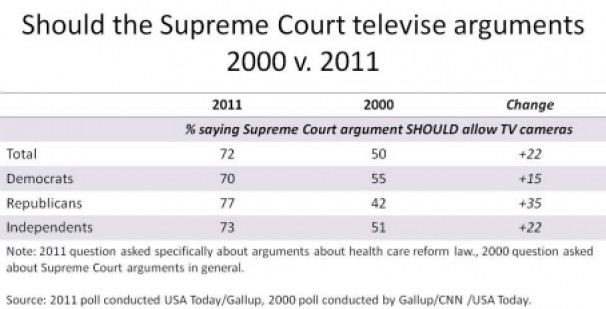This spring, Life of the Law had the exciting opportunity to work with students at Macalester College on writing about the law and their lives. This week, we’re sharing four of the blog posts that came out of this collaboration … and they’re really good. Here is today’s by student Joe Klein.
I’m not going to lie; I’m as close as you can get to a C-SPAN junkie. During big legislative debates, such as the passage of the Affordable Care Act, I found myself glued to the live stream of the House and Senate floors, watching congressmen make their arguments and cast their votes. On occasion, I’ll have it playing in the background as white noise, even when I know nothing interesting or exciting is going to happen on the floor. Regardless, it’s fascinating watching the legislative process play out like that, and I feel more connected to, and informed about, Congress simply by watching their work take place.
It’s pretty undisputed that having cameras on the House and Senate floors is a good thing, and I’d be hard-pressed to find someone who argues for removing them. They give unfiltered, authentic access to Congress. Off and on, there have been debates on whether the Supreme Court should allow their proceedings to be televised as well. Supporters of cameras have used the same logic that applies to cameras in Congress; it better connects people with their government and would allow them to get a better sense of how the judicial process plays out.
Federal Rule 53 states that “except as otherwise provided by a statute or these rules, the court must not permit the taking of photographs in the courtroom during judicial proceedings or the broadcasting of judicial proceedings from the courtroom,” and that provision was later expanded to prohibit television coverage of court proceedings. Currently, the Court releases audio files and transcripts of arguments it hears, but often that won’t be until well after arguments have concluded. They’re difficult to locate as well; you have to navigate online through supremecourt.gov — hardly an ideal system for a branch of government that’s often perceived as being insulated and distant from the public.
The Court is often perceived as the branch of government that’s most distant from the public, and most unaccountable. They don’t have to face the voters, and don’t have the pressure of elections to guide their decisions. They are safe. Therefore, the fear that they’ll begin retooling their oral arguments to play toward the cameras, and aim for the best soundbite rather than the most substantive argument, is unwarranted. The intention of having cameras in the courtroom isn’t to pressure them or make them change their behavior. There’s no need, or desire, to make them more subject to public pressure. It’s all about awareness. Think how many Americans would have watched a live video of the Court arguing Perry and Windsor (the marriage equality cases) earlier this year, or another high-profile case that dominated the news cycle.
Polls show that the public’s knowledge of the Court is embarrassingly low. A staggering number of Americans (65 percent) couldn’t name a single member of the current Court when asked. In addition, trust and approval in the judicial branch has been decreasing — only 52 percent view it favorably, a historically low figure.
On the other hand, there are plenty of people who want to be involved in issues pertaining to the Court. During the Perry arguments, the contest to obtain one of the few seats available in the chamber to the public was tough and contentious, to the extent that people were lining up outside the building days in advance and hiring “line-standing” services to secure them a spot. Instead of having to battle for a spot in the courtroom days in advance, someone should be able to simply turn on their television and watch the oral arguments take place.
It goes without saying that the decisions that take place in the Court’s chambers are crucial, and affect everyone at one point or another. Especially when considering how inaccessible the Court can appear at times, it’s imperative that outlets are opened that allow the public to interact with this branch of their government. People have a right and a responsibility to be aware of their government and its impact on their lives. However, they can’t exercise that right or responsibility when very limited tools exist for them to do so. Bringing cameras into the courtroom of the Supreme Court would go a long way in making the Court more accessible to the public, to the extent where individuals are able to see its impact in their daily lives in a simpler, more effective manner.









